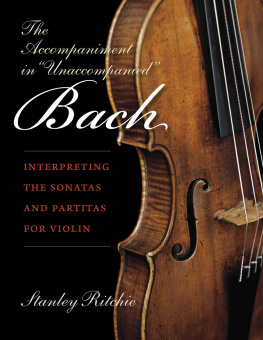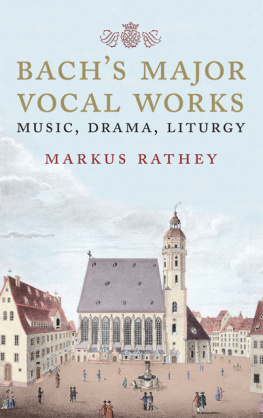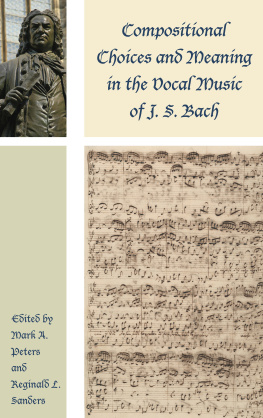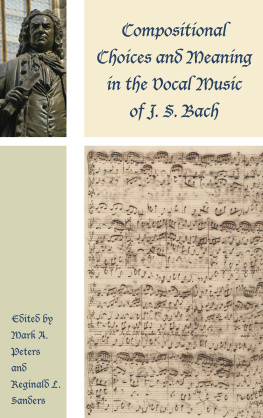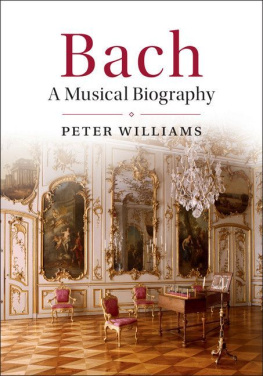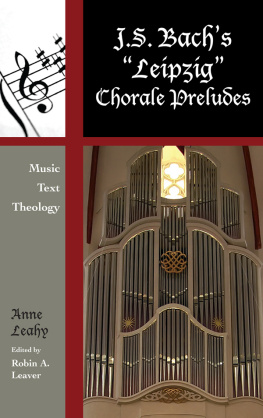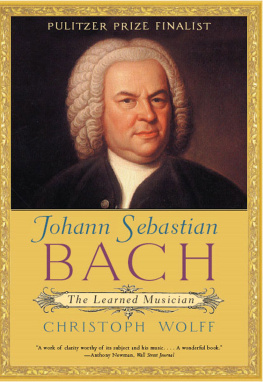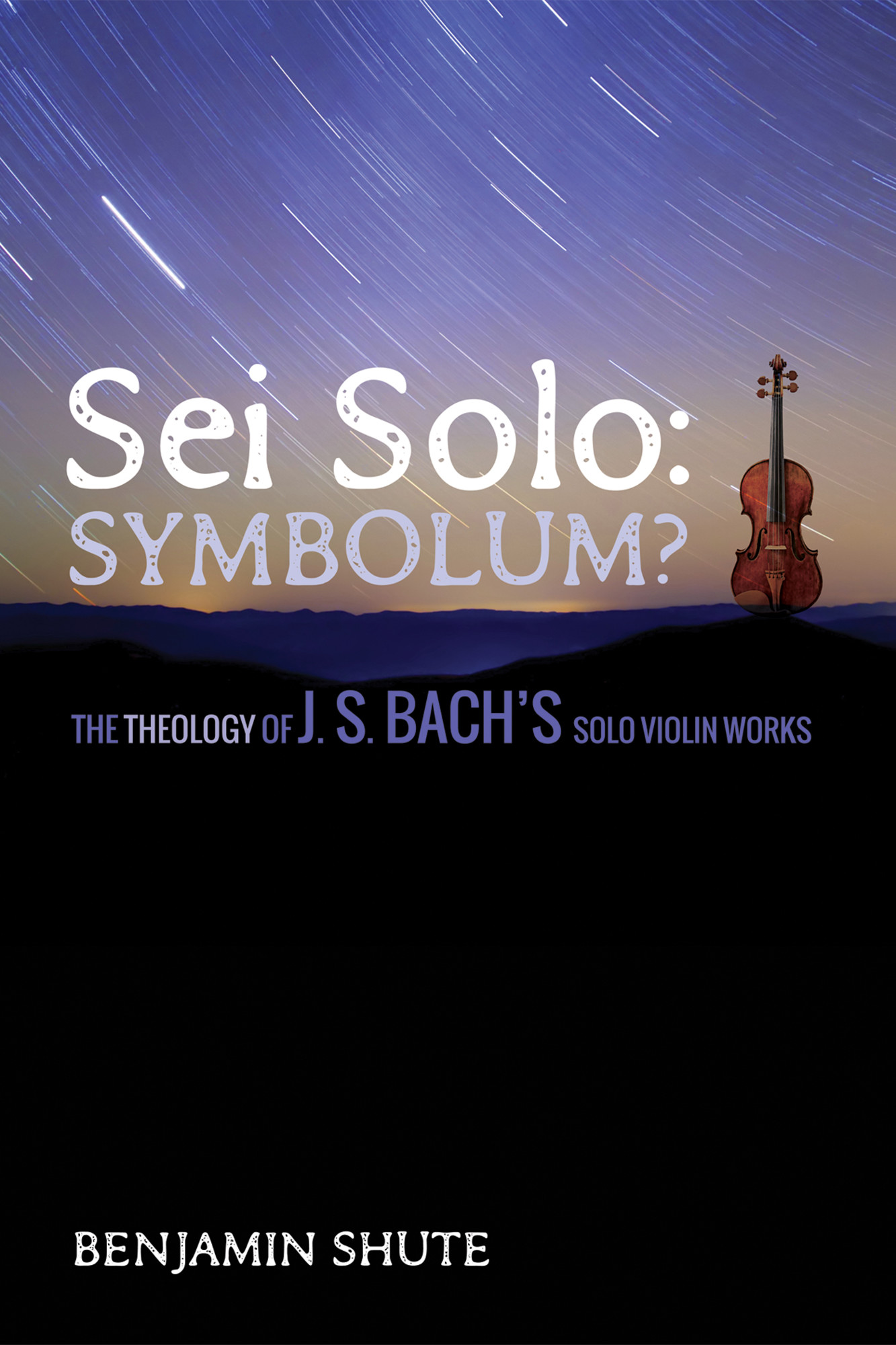The Theology of J. S. Bachs Solo Violin Works
Preface
I n the context of the music of J. S. Bach, the Latin word symbolum carries two principal meanings. First, it can mean a symbol or representation, as in two of Bachs canons that bear the inscriptions Symbolum . Christus Coronabit Crucigeros (Symbol: Christ will crown those who carry the cross) and Symbolum . Omnia tunc bona, clausula quando bona est (Symbol: All is then well that ends well). The second meaning of symbolum is creed, as in the Symbolum Nicenum or Nicene Creed. The title of this study refers to its central question: Is it possible that Bach uses musical devices in his collection of unaccompanied violin works, the Sei Solo, to symbolize his devoutly held Lutheran faith, thus making it something of a confession or creed in tones?
This study will propose that Bachs solo violin works do indeed contain a theological dimension that unfolds according to the Biblical Christ-narrative. And I should be very clear from the outset that this idea is not new; neither are several elements of the basic outline I will propose, namely, that the nativity of Christ is represented in first sonata in G minor while the juxtaposed D-minor partia and C-major sonata are the locus of passion-resurrection imagery. These ideas have long been hovering, so to speak, in the collective musical consciousness, and variants of them have been prominently articulated in recent years by musicians including Paul Galbraith and Helga Thoene. What has not yet appeared, however, is a defensible demonstration of the likelihood that Bach did (or did not) conceive the Sei Solo to contain this hypothesized dimension of theological allegory. For instance, most arguments proposing the theological dimension have fallen into one of two categories: on one hand, those that use logically or musicologically indefensible methods, often numerological (see Appendix A); and on the other hand, those that rest primarily on interpretation of the musics emotional content, which may be valid but which nonetheless falls outside the more scientific sphere of musicology. Consequently, the idea of the Christ-story embedded in the Sei Solo has assumed the quality of a myth that can be neither confirmed nor dispelled, being just plausible enough to seem credible but not concrete enough to be demonstrated in any meaningful way.
For this reason, I have been inclined to approach the idea of spiritual signification in Bachs solo violin works with a degree of skepticism, and indeed it is not without considerable self-consciousness that I publish my observations on a subject that many have already (and, I submit, prematurely) relegated to the sphere of musicological pulp fiction. I must clearly emphasize that my starting point for the present study has not been a desire to seek the rumored spiritual symbolism of Bachs violin works, much less a resolve to discover it. After all, it is easy enough to discover evidence for a foregone conclusionand in most cases to persuade a few others along the way. Rather, as a violinist regularly engaging these works over a number of years, I began noticing that prominent or unusual musical elements within the six solos create complex yet elegant parallels with the theological views we know Bach held, by means of methods resembling those abundantly found in his vocal works. Pursuing this further led me to an understanding of Bachs solo violin works as containing a degree of theological representation that I have not commonly observed in his other instrumental music, which is to say, if my methodology could detect the same significances in any work or collection to which I turned my gaze, I would have to be most suspicious of it.
Presenting the results of my inquiry into Bachs violin works has been the reason for this study, and therefore I must emphasize that it is primarily a work of musicology, not of theology. In other words, my intent has been to reference the theological considerations that appear relevant to Bachs solo violin works, not to use Bachs violin works as a springboard for a comprehensive and systematic study of his theological milieu. Naturally, the broader subject matter of the present study could furnish material for a volume far more substantial than this; but my goal has been to streamline the discussion as much as possible without compromising the depth necessary to lay as solid a foundation as I am able for my premise.
A few brief comments may be in order about some of my material and its presentation. It is, of course, essential that any proposition of theological signification in Bach proceed with an awareness of Bachs own theological outlook, as best it can be determined. But, having situated Bach as an Orthodox Lutheran who appears to have been sympathetic to the devotional emphasis of Pietism,
Because this gospel is called the good news in Greek (, euanglion ), I have approached it as such in the study that follows, seeing no reason either to project a cynical tone or to obscure what eighteenth-century Lutheranism, in common with historic Christianity, understood to be its essential message by dwelling on secondary matters as though they were primary. But I feel constrained to add that my reasons for wanting to accurately convey this gospel (as understood by Lutheranism) in content, emphasis, and tone also prohibit me from wishing to portray any of the persons relevant to this study in a way that is less than historically faithful. I am thinking of a certain hagiography or at least idealization that is sometimes to be found in purportedly historical writings on Christian figures that can at times involve a degree of whitewashing that is both out of step with the aims of scholarship and, perhaps more to the point in such cases, ironically at odds with the very worldview they would appear intent on flattering, since a false balance is an abomination to the LORD, but a just weight is His delight. I mention this in order to emphasize that I do not intend for anything I cite concerning the beliefs or output of Bach, Luther, or anyone else to have any ramifications for their life, character, or psychology; but I specifically want to avoid the implication (and the inference) that their adherence to the message of the good news suggests either the state or the status of saintliness as it is popularly conceived.
In this connection it is appropriate to recall what is often the elephant in the room of Lutheran theological studies, the virulent anti-Jewish sentiments that Luther expressed particularly in his later years, Although Luthers anti-Jewish views appear to represent a comparatively small portion of his thought-worlda portion that does not pertain to the following studyI nonetheless recognize the disproportionate and profoundly harmful effect these views have subsequently had; and in light of that I have felt it appropriate to mention them here, if only superficially, so that their absence in the following pages will appear neither as a whitewashing of history nor as tacit consent to their equation with New Testament teachings, which in good conscience seems entirely unfounded to me. But here ends my commentary. In the pages that follow, I approach the perspectives of Bach, Luther, and Lutheranism to document rather than to evaluate as I trace the line of reasoning that makes it seem overwhelmingly likely to me that Bachs collection of solo violin works uses musical devices to represent what he appears to have believed about Christ and the hope of redemption.




